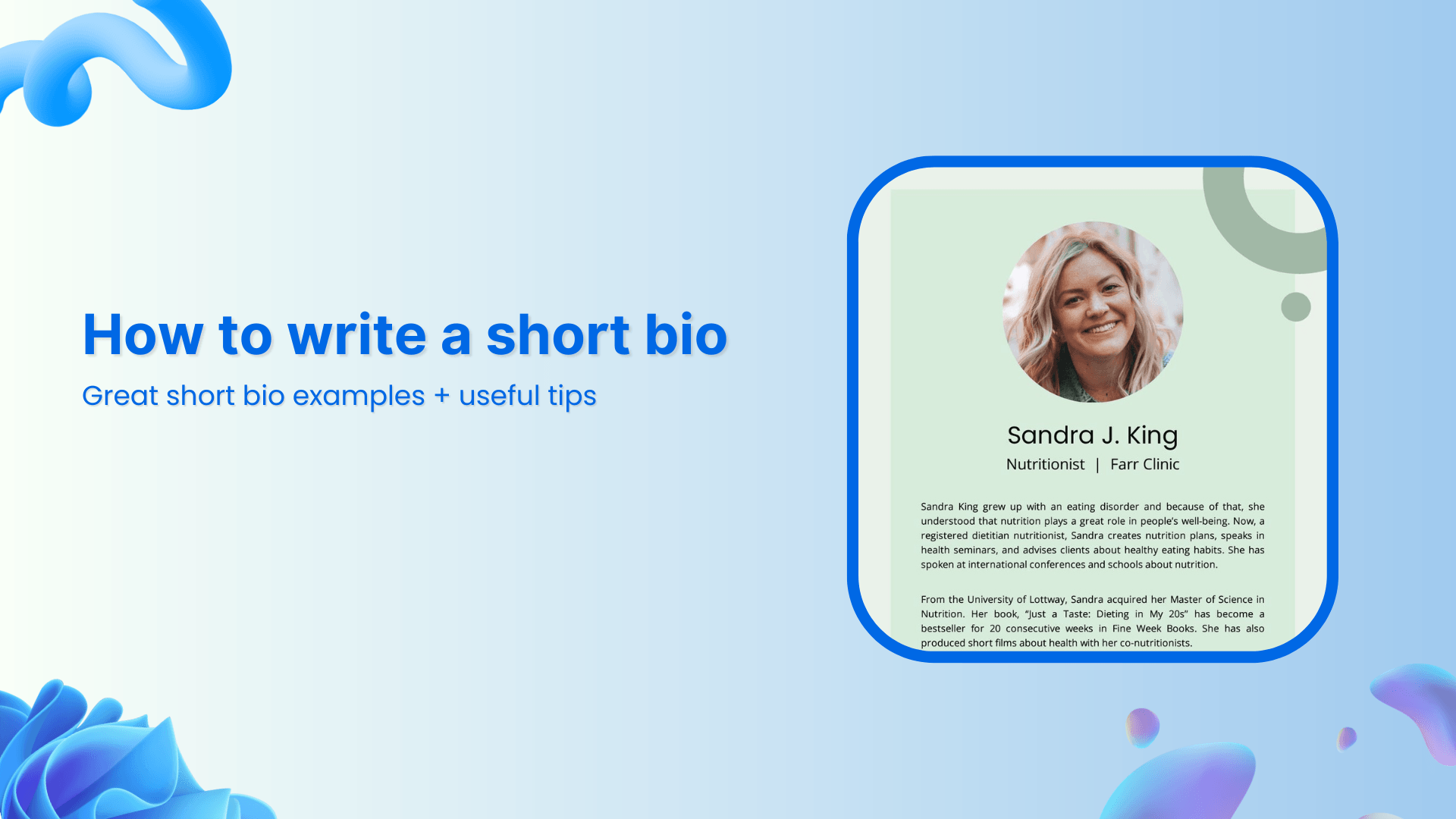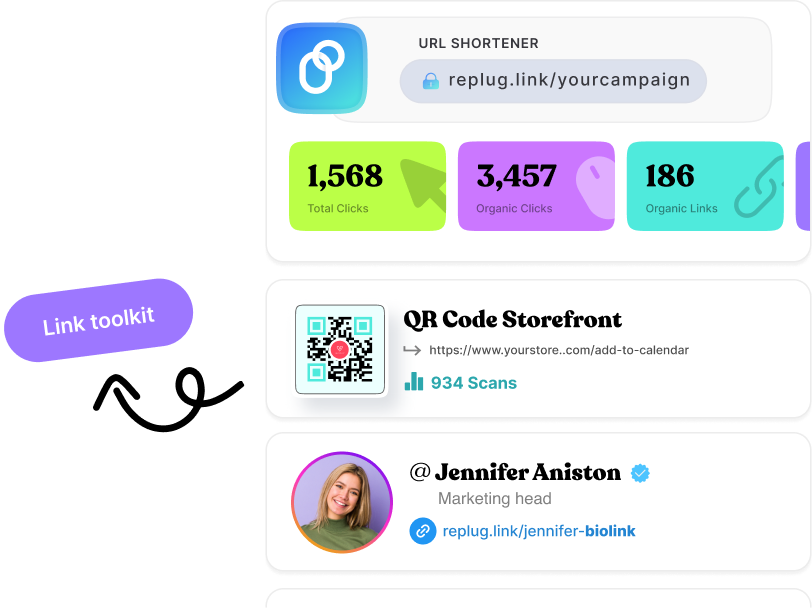How to write a short bio: Great short bio examples + useful tips

Do you ever stare at a blank screen, trying to write just a few lines about yourself, and end up deleting more than you type? That’s a super common problem.
In fact, many people struggle to craft a bio that feels genuine and packs a punch. The madness is quite real. A weak or vague bio can make you sound forgettable, costing you clicks, connections, or even job offers.
But here’s the good news!
With a little strategy, you can write a short bio that boosts your credibility, showcases your personality, and holds attention.
In this post, we’ll guide you step by step through great short bio examples and actionable tips. First up, let’s take a brief overview of what exactly a short bio is.
So, let’s get started!
What is a short bio?
A short bio is a tight, focused summary of who you are, what you do, and why it matters. Unlike a complete resume or CV, it tells your story in just a few sentences, typically in the first or third person.
Its main goal is to introduce you in the most memorable and relevant way quickly. You might see it on personal websites, LinkedIn profiles, author bylines, or event speaker pages.

A well-crafted short bio isn’t just a list of facts. It humanizes you, highlights your strengths, and gives readers a reason to connect with you.
As personal branding grows ever more critical, especially when 70% of employers check social media profiles before hiring, your bio becomes a tiny but powerful part of your professional identity.
When do you need a short bio
You’ll want a short bio in a bunch of everyday situations:
- On your website or portfolio: To welcome visitors and give them a glimpse of who you are and what you do.
- LinkedIn, social media, or networking profiles: It’s your digital handshake.
- At events: Whether you’re speaking, contributing, or just being featured, you’ll often need a bio to introduce yourself.
- In content bylines or guest posts: When you write for someone else’s blog or publication, a short bio shows readers why they should trust and follow you.
What should be included in a short bio: Key elements discussed
A strong short bio hits all the right notes, giving a quick, well-rounded snapshot of who you are, what you do, and why it matters.
Here are the essential pieces to include:
- Your name: Start by clearly stating who you are. That’s your identity and the foundation of everything else.
- Job title or workplace: Add your current role or company to ground your bio in your professional life.
- University degree & other qualifications: Mention your education or certifications to highlight your background and expertise.
- Hometown or city of residence: A small detail like where you’re from adds a human touch and context for your audience.
- Personal or professional goals: Include what you’re aiming for. This shows direction and ambition.
- Mission statement & values: What drives you? A brief line on your core beliefs or purpose makes your bio more meaningful.
- A relevant professional achievement, milestone, or accomplishment: Highlight something concrete. It can be a project, an award, or a result you’re proud of.
- Skills & area of expertise: Be specific about what you’re good at. This helps people understand where you excel.
- Personal interests & hobbies: Sprinkle in a hobby or passion. It makes you more relatable and shows there’s more to you than just work.
- Your LinkedIn profile, social media accounts, or other contact information: Finally, give people a way to reach out or connect, so your bio doesn’t just end; it opens doors.
Each of these pieces helps build a bio that’s professional, personal, and memorable, without feeling like a resume stuffed into a paragraph.
How do you write a good short bio?
Writing a great or compelling short bio is really about finding the right balance. You want it to be professional, but also feel like you.

Here’s how to do that, step by step! Check out the key components:
- Choose a voice: First, decide whether you’ll write in first person (“I am …”) or third person (“Jane Doe is …”). This choice sets the tone for everything that follows.
- Introduce yourself: Begin with a quick, brief line that states your name and gives a sense of who you are.
- State your company or brand name: If you work for or run a company, mention it. It adds context and credibility.
- Explain your current professional role: Describe what you do in your job or business, so people immediately understand your value.
- State your philosophy: Share the mission, values, or work philosophy that motivates you. It helps people connect with why you do what you do.
- Highlight professional achievements, skills, & expertise. Include one or two standout wins or key strengths that set you apart, without turning into a resume dump.
- Discuss your passions & core values: Let readers in on what matters to you personally and professionally. This is what makes your bio meaningful.
- Mention your personal interests & goals. A line about what you love doing outside of work, or where you’re headed, makes your bio feel human.
- Add a personal touch: No matter if it’s an odd hobby, a fun fact, or a short anecdote, this makes you memorable.
- Include a call to action: Wrap up by inviting people to connect. Link to LinkedIn, your website, or encourage them to reach out.
Putting these together will give you a short bio that’s polished and professional, yet warm, honest, and very you.
Read also: What does link in bio mean: All you need to know
General short bio template
Here’s a simple, basic, and flexible template you can alter effortlessly. Use the “blanks” as guides, and just fill in your personal details to make it your own.
[Your Name] is a [Your Job Title/Role] at [Your Company/Organization]. [He/She/They] specializes in [Your Key Skill/Area of Expertise] and has achieved [Your Most Notable Achievement]. In [his/her/their] spare time, [he/she/they] enjoys [A personal hobby or interest]. You can connect with[him/her/them] via [Contact Information/Link].
Short bio template for students
[First Name, Last Name] is a current [year] student studying [major] at [university]. [He/She/They] is actively involved in [campus activity or club], where [brief description of role or achievement]. During a recent internship at [organization], [he/she/they] worked on [project or task], gaining experience in [skill or area]. [He/She/They] hopes to build a career in [industry or field] and is passionate about [personal interest or goal]. In [his/her/their] free time, [he/she/they] enjoys [hobby] and connecting with others on [LinkedIn or other social media platforms].
Short bio template for working professionals
[First Name, Last Name] is a [job title] at [company name], with [number] years of experience in [industry or specialty]. [He/She/They] focus on [core responsibility or niche], and have helped [type of clients or audience] by [key achievement or frequent value delivered]. [His/Her/Their] philosophy is [brief mission or value statement], and [he/she/they] brings strengths in [skill 1], [skill 2], and [skill 3]. Outside work, [he/she/they] is passionate about [interest or cause], and you can reach [him/her/them] via [LinkedIn, website, or email].
Short bio template for a gap in employment
[First Name, Last Name] is a [previous job title or role] with [number] years of experience in [industry]. After taking time off to [brief reason for gap — e.g., upskill, care for family, personal development], [he/she/they] focused on [what you did during the gap, like courses, volunteering, projects]. During this period, [he/she/they] strengthened [his/her/their] skills in [skill or area] and completed [relevant achievement or learning]. Now, [he/she/they] is excited to return to [industry/role] and bring [his/her/their] unique perspective and experience to [type of role or organization]. Feel free to connect with [him/her/them] on [LinkedIn or other contact].
10+ top-notch “how to write a short bio” examples
Writing a short bio might seem tricky at first, but it’s a great way to highlight your achievements and personality in a concise, effective way.
Doesn’t matter if you’re writing one for yourself, someone else, or a professional context, the goal is to keep it relevant, engaging, and to the point.
Here’s how to approach writing short bios for different scenarios.
How to write a short bio about yourself
When writing a short bio about yourself, focus on the essentials: who you are, what you do, and what makes you unique.
You don’t need to write your life story; just a brief summary that showcases your expertise, interests, or accomplishments. A good format to follow is:
- Your name and current role or major project
- One or two sentences about your professional background, key skills, or current focus
- A personal touch, such as hobbies or passions
Example:
“Hi, I’m Sarah Lee, a digital marketing strategist with over 5 years of experience helping brands grow online. I specialize in social media campaigns and SEO. Outside of work, I love hiking and exploring new coffee shops.”
How to write a short biography about myself
A short biography about yourself is slightly more formal than a casual bio, often focusing on your professional history and key achievements. Here, you want to balance humility with confidence.
Keep it brief but impactful, summarizing the highlights of your career, education, or other noteworthy accomplishments.
Example:
“I’m John Smith, an award-winning journalist with a passion for investigative reporting. Over the past decade, I’ve worked for major publications like The New York Times and BBC News. I hold a degree in Journalism from Columbia University, and my work focuses on political analysis and social justice.”
How to write a short biography about someone
When writing a bio about someone else, your job is to capture their professional essence and achievements without over-elaborating. Keep the tone respectful, and focus on their key milestones, what they do, and why they stand out.
Example:
“Dr. Emily Zhang is a renowned environmental scientist known for her groundbreaking research on renewable energy solutions. With a PhD from MIT and over 15 years of experience, she has authored several influential papers and currently leads a research team at GreenTech Innovations.”
How to write a short bio for social media
Social media bios need to be quick, catchy, and aligned with your personal brand. It’s all about making a strong first impression in a limited space.
For platforms like Twitter or Instagram, you may want to include a mix of professional titles, personal interests, and a hint of humor or personality.
Example:
“Marketing pro | Coffee addict | Lover of good books & bad puns | Helping brands tell their story | Always up for a challenge.”
How to write a short bio for work
Work bios are typically found on company websites or in team directories, so they should be professional but approachable. Highlight your role, skills, and what you bring to the team, without going overboard with personal details.
Example:
“Jane Davis is a Senior Product Manager at TechSoft, where she leads product development for the company’s flagship software. With a background in engineering and a passion for innovation, Jane works closely with cross-functional teams to deliver solutions that meet customer needs.”
How to write a short bio for a new job
When starting a new job, a bio helps introduce you to colleagues, clients, or customers. Focus on your previous experiences that are relevant to the role you’re stepping into, and mention what excites you about your new position.
Example:
“Alex Carter has recently joined TechLink as a Software Engineer, bringing with him 3 years of experience in full-stack development. He is eager to collaborate with the talented team at TechLink and contribute to building innovative web applications.”
How to write a short bio for a presentation
For a presentation, your bio should quickly establish your credibility on the topic at hand. Keep it short, but highlight relevant qualifications or experience that make you an expert on the subject.
Example:
“Maria Gonzalez is a cybersecurity expert with over 10 years of experience helping businesses secure their digital assets. She has consulted for Fortune 500 companies and is a regular speaker at cybersecurity conferences worldwide.
How to write a short bio for a conference
Conference bios should be concise but informative, highlighting your expertise in the field and any notable accomplishments. Since attendees want to know why you’re speaking at the event, mention key achievements that are relevant to the audience.
Example:
“Dr. Brian Lee is a leading AI researcher at GlobalTech Labs and a keynote speaker at this year’s AI Innovation Conference. With a PhD in Machine Learning from Stanford, his work focuses on the ethical implications of AI in healthcare.”
How to write a short bio for a company
When writing a bio for a company, focus on the company’s core values and your specific role or contribution to its success. It’s a good place to mention any leadership roles or initiatives you’re involved in.
Example:
“Susan Mitchell is the Chief Marketing Officer at GreenCo, where she oversees global marketing strategies. Her leadership has been instrumental in expanding GreenCo’s brand presence, driving record growth in the past two years.”
How to write a short bio for a personal website
A short bio on your personal website should feel a bit more personal, reflecting both your professional and personal sides. It’s an opportunity to showcase your personality and explain what drives you in your work or life.
Example:
“Hi, I’m Michael Brown, a freelance graphic designer passionate about creating impactful visual identities. I work with startups to help them tell their story through design. When I’m not designing, you’ll find me playing guitar or traveling to new places.”
How to write a short bio for a marketing professional
A marketing professional’s bio should highlight relevant industry experience, skills, and achievements. Emphasize your role in growing businesses or developing successful campaigns, and don’t forget to mention any certifications or expertise in specific areas of marketing.
Example:
“Rachel Thomas is a digital marketing strategist with 7 years of experience helping businesses scale through data-driven campaigns. She specializes in content marketing, SEO, and analytics, and has helped over 50 brands increase their online presence.”
How to write a short bio for an executive
Executive bios should be more formal and reflect the leadership role the person holds within the organization. Focus on their career trajectory, key accomplishments, and how they’ve contributed to the company’s growth.
Example:
“John Roberts is the CEO of InnovateTech, where he has led the company through significant growth, expanding into international markets and increasing revenue by 200% over the past 5 years. With over 20 years of leadership experience, John is a passionate advocate for innovation in the tech industry.”
Writing a short bio doesn’t have to be complicated. No matter if it’s for a social media profile, a professional context, or a personal website, just focus on the essentials and be authentic. With the right balance of information and personality, you’ll have a bio that truly represents you!
Short bio vs. professional bio: Major differences
Here’s a quick breakdown of how a short bio differs from a professional bio so that you can pick the right style for your needs:
| Aspect | Short bio | Professional bio |
| Length | Very brief, usually 50–150 words or 3–5 sentences. | More detailed, often 150–300 words, though full versions can go up to 500+. |
| Purpose | A quick snapshot to introduce yourself in limited-space contexts (e.g., social media, conference programs, author bylines). | A fuller narrative of your career. Ideal for personal websites, company “About” pages, or professional portfolios. |
| Content focus | Focuses on key points: your name, current role, core expertise, and a highlight or two. | Goes deeper: includes past experience, major achievements, philosophy, and sometimes personal details. |
| Tone | Short, punchy, and often conversational. | More formal, though still friendly, especially if it’s for your brand or company. |
| Usage | Great for bios on LinkedIn headings, email signatures, social media, or speaking slides. | Used in professional settings like company “Team” pages, press releases, or detailed “About Me” sections. |
In short: Use a short bio when you need to introduce yourself fast and leave a strong first impression. Whereas, use a professional bio when you want to tell more of your story, highlight achievements, and show your personality in a richer way.
Also read: How to write a professional bio: best tips and tools
Why writing a short bio feels hard: What to do to make it easier
Crafting a short bio often feels tougher than it looks, because you’re trying to sum up your whole story in just a few lines, and that can make you overthink what to include or leave out.
Common challenges:
- You’re too close to yourself, so it’s hard to know what parts of your journey actually matter.
- It’s a delicate balance: You want to sound capable and professional, but also approachable, and that tone trip can be tricky.
- Figuring out your audience: If your bio is everywhere (LinkedIn, your website, a conference), you risk writing something too generic that doesn’t truly speak to anyone.
- Editing can be brutal: Trimming language, removing filler, and still keeping meaning is exhausting.
How to make it easier:
- Start with perspective: Try writing your bio about someone else as if it’s your colleague. This can help you detach and pick the most important bits.
- Be clear on your goal: Ask yourself why this bio exists. Do you want to connect with clients, impress hiring managers, or just show your personality? That clarity helps you pick what to highlight.
- Focus on what matters: Choose the most substantial achievements and keep personal touches, but don’t overload. Remember, the best bios are concise and relevant.
- Use your real voice: Ditch the buzzwords and write like you speak. That makes your bio feel genuine and authentic.
- Get feedback & edit: Write a draft, take a break, then come back to alter. Ask a friend or colleague to read it, since fresh eyes catch what you might miss.
- Update after a period: Your bio isn’t set in stone. As things change, such as new roles, big wins, and new passions, come back and tweak it.
That said, you don’t have to get it perfect on the first try. A short bio is a living, breathing thing. Write something, test it out, and improve it as you grow.
Quick tips for writing a short bio: Best practices to follow
Writing a sharp, memorable short bio doesn’t have to be a headache. Here are some friendly, practical tips to keep it effective and real.
- Start by keeping it brief & concise. Every word counts, so cut the fluff and get to the point.
- Be authentic & honest about who you are. People connect more when you don’t overinflate things.
- Always review any guidelines (e.g., character limits or tone) for the platform where your bio will appear. This keeps you on track.
- Tailor your content accordingly to match that platform. For instance, LinkedIn might need a different feel than Instagram.
- Think about your target audience as you write. What do they want to know, and what kind of tone will resonate with them?
- Pick a point of view. Many prefer writing in the third person for professionalism, especially in formal settings.
- Look at examples for inspiration, but don’t copy as it is; make it yours.
- Focus on clarity over creativity. Being understood is more important than being jazzy.
- Add humor when it feels natural, but don’t force jokes. A small personal line can make you human.
- Always include a link to your website or portfolio, so people can learn more about you easily.
- Adapt your bio for different platforms. Don’t just copy-paste the exact text everywhere. It can give a monotonous feel.
- Mention relevant hobbies so you come across as well-rounded, but don’t go overboard.
- Consider using a template if you’re stuck. It can help you structure things neatly.
- Use SEO smartly. Naturally, incorporate 1–2 relevant keywords that match your field.
- Consider ending with a CTA. Invite people to connect or check your site.
- And finally, proofread & edit thoroughly. Typos or awkward phrasing can pull people out of your story.
Note: Following these points will help you craft a bio that’s polished, personal, and ideally suited for your goals.
Wrapping up!
Writing a short bio doesn’t have to feel like a tedious task anymore!
Once you know what to include, how to structure it, and how to keep things clear and honest, it becomes a simple way to introduce yourself with confidence.
Whether you’re a student, a pro, or someone rebuilding their career story, the right bio helps people understand who you are and what you bring to the table.
So take your time, follow the steps, and craft something that actually sounds like you!
And suppose you want to level up your online presence, give Replug a try now. It’s one of the best custom URL shorteners for creating branded short links, and it even offers a bio links feature to help you build clean, custom bio pages that connect all your content and offers.
Frequently asked questions
What is a small bio or a mini bio?
A mini bio is an ultra-compact introduction, usually one or two sentences, that sums up who you are, what you do, and why it matters. It’s perfect for social media profiles or bylines.
What is a 3-line bio?
A 3-line bio typically covers your name and role, your mission or philosophy, and a key achievement, allowing you to present a quick yet complete snapshot.
Here’s a clean, 3-line bio example:
“I’m Ashley Cole, a product designer passionate about creating intuitive user experiences. My mission is to make complex tools simple and accessible for everyone. I helped design the XYZ app, which now serves over 200,000 users monthly.”
What makes a great short bio?
A great short bio is transparent, authentic, and focused. It highlights your role or value, touches on your personality or mission, and makes people want to learn more.
How do I write a short bio about myself?
Here’s how to do it:
1. Start with your name and role,
2. Then, mention one or two strengths or achievements,
3. Finally, add a personal note or value to humanize it.
Which one to use, first-person or third-person, while writing a short bio?
First-person (“I”) works well on personal sites or social media for a conversational tone. Third-person (“She/He/They”) feels more formal and objective, so it’s often used in speaker profiles or press pages.
What are the dos and don’ts of crafting a short bio?
Do’s:
– Be authentic: Write in your own voice and don’t pretend to be someone you’re not.
– Highlight your current role and what you do: Give readers a clear idea of your professional identity.
– Share what drives you: Include your mission, values, or philosophy to give your bio purpose.
– Add a personal touch: Mention a hobby or detail that reveals who you are beyond your work.
– Proofread carefully: Check for typos, grammar mistakes, and clarity.
Don’ts:
– Don’t exaggerate or lie: Stick to real, verifiable facts.
– Don’t make it too formal or stiff: Your bio should be professional, but not robotic.
– Don’t overload with details: Avoid listing every accomplishment; focus on the most relevant ones.
– Don’t use overused buzzwords: Words like “innovative” or “disruptive” without context don’t add real value.
